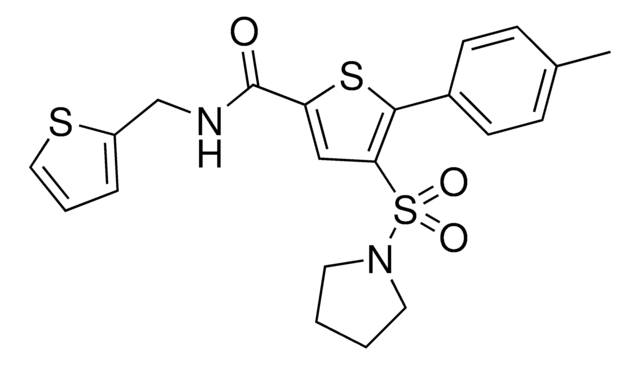573097
STAT3 Inhibitor III, WP1066
STAT3 Inhibitor III, WP1066, CAS 857064-38-1, is a cell-permeable AG490 tyrphostin analog that acts as a STAT3 pathway inhibitor. A potent anti-tumor agent.
Sinónimos:
STAT3 Inhibitor III, WP1066
About This Item
Productos recomendados
Nivel de calidad
Análisis
≥97% (HPLC)
formulario
solid
fabricante / nombre comercial
Calbiochem®
condiciones de almacenamiento
OK to freeze
protect from light
color
off-white
solubilidad
DMSO: 10 mg/mL
ethanol: 5 mg/mL
Condiciones de envío
ambient
temp. de almacenamiento
2-8°C
InChI
1S/C17H14BrN3O/c1-12(13-6-3-2-4-7-13)20-17(22)14(11-19)10-15-8-5-9-16(18)21-15/h2-10,12H,1H3,(H,20,22)/b14-10+/t12-/m0/s1
Clave InChI
VFUAJMPDXIRPKO-LQELWAHVSA-N
Descripción general
Acciones bioquímicas o fisiológicas
STAT3 pathway
Envase
Advertencia
Reconstitución
Otras notas
Información legal
Código de clase de almacenamiento
11 - Combustible Solids
Clase de riesgo para el agua (WGK)
WGK 2
Punto de inflamabilidad (°F)
Not applicable
Punto de inflamabilidad (°C)
Not applicable
Certificados de análisis (COA)
Busque Certificados de análisis (COA) introduciendo el número de lote del producto. Los números de lote se encuentran en la etiqueta del producto después de las palabras «Lot» o «Batch»
¿Ya tiene este producto?
Encuentre la documentación para los productos que ha comprado recientemente en la Biblioteca de documentos.
Los clientes también vieron
Nuestro equipo de científicos tiene experiencia en todas las áreas de investigación: Ciencias de la vida, Ciencia de los materiales, Síntesis química, Cromatografía, Analítica y muchas otras.
Póngase en contacto con el Servicio técnico
